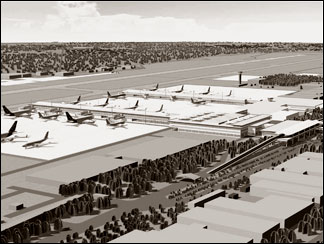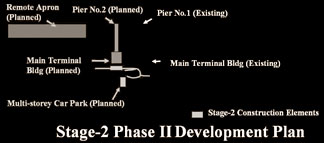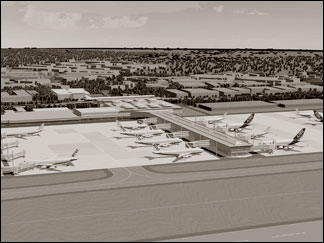|
Development of Bandaranaike International Airport (BIA):
BIA will be a model airport to be proud of - Chandima P Rasaputra
By Indeewara Thilakarathne
[email protected]
|

Chandima P Rasaputra
|
With the completion of the second Phase of the BIA development
programme, BIA will see an unprecedented level of development, making it
one of the best airports in the region and a model airport to be proud
of.
The comprehensive master plan will include the construction of the
second runway, multi-storied terminals, remote parking structures, a
road network, which will be on two levels, catering for to arriving and
departing passengers and complementary the allied infrastructures such
as a Transit Hotel with fifty rooms at the Airport, Airport Hotel
outside the Airport, a tax-free zone and a railway line from Colombo to
Katunayake. The emerging infrastructure will also be augmented by the
construction of the Katunayake - Colombo super high way.
In an exclusive interview with Sunday Observer, Chairman of Airport
and Aviation Services (Sri Lanka) Limited, Chandima P. Rasaputra
elaborates on the master plan that will make BIA, the gateway to Sri
Lanka, - a passenger-friendly and model airport in the region.
Following are the excerpts of the interview
What is the current status of the BIA
compared to other regional airports?
 A: Currently, Bandaranaike International Airport (BIA) enjoys
the number one position in the region of South Asia. The airport stands
out Ours is much better than any of the Indian airports in terms of
facilities as well as the level of services. BIA provides. This is, of
course, not my own opinion but the opinion of many of Indian airline
operators such as Jet Air and Air Sahara, which are operating here. A: Currently, Bandaranaike International Airport (BIA) enjoys
the number one position in the region of South Asia. The airport stands
out Ours is much better than any of the Indian airports in terms of
facilities as well as the level of services. BIA provides. This is, of
course, not my own opinion but the opinion of many of Indian airline
operators such as Jet Air and Air Sahara, which are operating here.
Annually, BIA handles up to 6 million passengers and the airport has
the capacity to handle up to 8 million passengers. However, as the
volume goes up, naturally, it will have an impact on the portfolio of
services as well.
The development programme of BIA is broken down into two Phases and
each Phase is once again, broken down into two stages.
The stages and 2 of Phase I and the second have already been
completed and the stage 1 of the Phase II was had been completed in
early 2006.
What are the major infrastructure facilities that will come up in the
second stage of Phase II of the development plan?
 A: Under the Phase II stage I, basically, the new pier and
aero-bridges were installed under Phase II, Stage 1. Earlier passengers
were transported up to the aircraft by bus and embarked the plane in by
using a ladder. Although the BIA, at the moment, has eight aero-bridges
at the moment, arriving and departing passengers are being handled on
the same level in a single pier. A: Under the Phase II stage I, basically, the new pier and
aero-bridges were installed under Phase II, Stage 1. Earlier passengers
were transported up to the aircraft by bus and embarked the plane in by
using a ladder. Although the BIA, at the moment, has eight aero-bridges
at the moment, arriving and departing passengers are being handled on
the same level in a single pier.
However, some airports have two levels of aero-bridges; arrivals on
one level and departures on another level and the aero-bridges
separately handle arriving and departing passengers. Under the Stage 2
of Phase II Stage II, for which, planning has already completed, and
consultation for the detailed design will commence within a one month’s
time and construction project will commence in 2009.
Under the project, BIA will construct a pier with separate 2-levels
of aero-bridges to separate for arriving and departing passengers. It
will have 16 aero-bridges, almost doubling the current capacity.
The pier will be constructed on eight parking slots although the
terminal will have two levels for arriving passengers and departing
passengers.
Basically the aero-bridges can be moved on, to suit the needs. With
the addition of the new pier and aero-bridges, BIA’s capacity for
passenger handling will increase from 6.58 million passengers to 12
million passengers per year. Currently BIA has 25 parking areas. Once
the second stage is completed, the number of parking areas for aircrafts
will also increase to 32.
Some of the remote parking areas which were for cargo transport will
also be utilised for passenger handling. The remote parking areas will
also be put to use utilised in instances where there may be a capacity
overflow or when BIA running out of capacity and aircrafts have to wait
a longer than the stipulated time. In such instances, passengers will
transported to the aircrafts by bus and embark by a ladder.
What is the development strategy
mapped out for BIA?
A: The corner stone of the current development strategy mapped
out for BIA is that we are going to make it a model airport in the
region. Switzerland which is not the biggest country in Europe, but it
is the model county in Europe, BIA will be a model airport in the
region.
 We will make BIA the most passenger friendly airport and efforts will
be made to ensure total hundred per cent customer satisfaction. The
service levels will be raised further to assure substantial reduction of
passenger waiting time in lines. even up to the reduction of passengers’
waiting time in lines. We will make BIA the most passenger friendly airport and efforts will
be made to ensure total hundred per cent customer satisfaction. The
service levels will be raised further to assure substantial reduction of
passenger waiting time in lines. even up to the reduction of passengers’
waiting time in lines.
A major portion of fundings for the project has already been
guaranteed by JBIC (Japan International Co-operation) and consultation
will commence in one month’s time. The project will consist of a
multi-storied terminal, remote parking structure with overhead bridge,
second runway and a multi-level road network.
A fifty-room transit hotel will be constructed in the airport and
another hotel may be constructed at the Eighteenth mile post. Though it
is not included in the stage II, we are also exploring the possibility
of setting up a Tax-free Zone and also to commission some kind of a
transportation system, - a railway line from Colombo to Katunayake as
well as a mono-rail operating between the airport and the eighteenth
mile-post.
New face for BIA
With the expansion of the BIA, not only does it get a modern face
with state-of-the-art facilities such as aero-bridges, but could proudly
compete with any other airport in the South East Asian region.
How many direct and indirect
employment opportunities that would be brought about by the expansion?
A: It will certainly
double or triple the man power that will be needed to handle operations.
The second terminal, and the number of shops that are going to be coming
up in the Tax Free Zone, will bring about further a lot of employment
opportunities. Additionally, the commercial activities in the Duty Free
Zone will generate one third of the BIA’s income. We anticipate the
creation of at least, 125 duty free shops that will emerge.
What kind of impact will the
expansion have on the cargo handling capacity of BIA?
A: Currently BIA handles 150 MT of cargo and has the capacity
to handle a volume of up to 250 MT with the use of the vacant idling
terminal. However, it will be in operation right after the SAARC summit.
Further, the space provided for airline offices in this vacant
terminal has not been utilized as of yet and will see occupation by the
end of the year.In the current terminals space constructed for airline
officers has not been utilised and by the end of this year.
Current space used by airline offices will be converted into
additional space for new shops. airline officers will be moved to that
area and the area occupied by airline officers will be taken up for
shops.
BIA at a glance
Nov. 01, 1957 - British Government handed over Katunayake Royal Air
Force base to Sri Lanka on November 1, 1957
Oct. 30, 1958 - Department of Civil Aviation, of Sri Lanka initiated
a programme to convert the Royal Air Force base into the main
International Airport of Ceylon
1962 - Canadian Government funded the initial development phase of
development of Katunayake airport under the Colombo Plan.
1981 - Master Plan for Katunayake Airport was completed by Canadian
joint Venture Consultants, of LEA ACRES & NORR
1987 - Phase 1 development project of Katunayake International
Airport was completed. in 1998
2006 - Stage 1 of Phase 2 was completed.
Future goals
* Runway overlay and meeting requirements for large aircrafts.
* Development of Airport access road, and land side curbs, including
split level terminal access.
* New Passenger terminal building (120,000m2) with segregated
departure and arrival areas to accommodate 6 million annual passenger
service Volume
* Pier (40 metres wide and 300 metres long) with segregated departure
and arrivals
* New parking aprons to accommodate 8 aircrafts car parks and
utilities |
